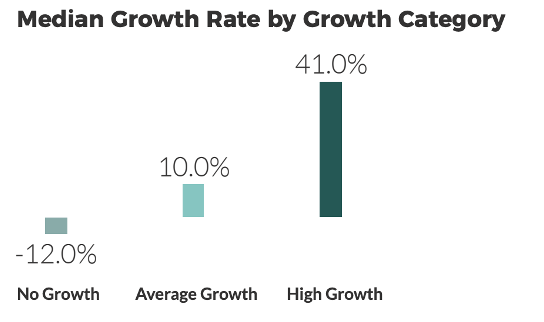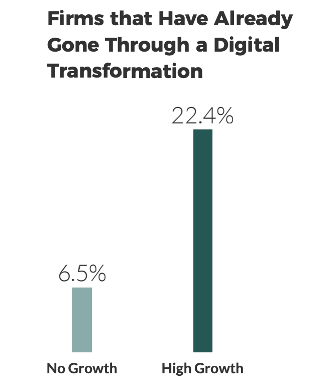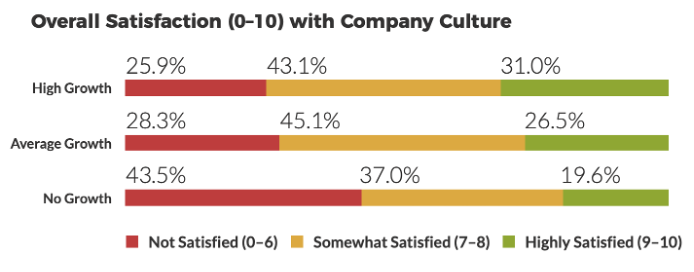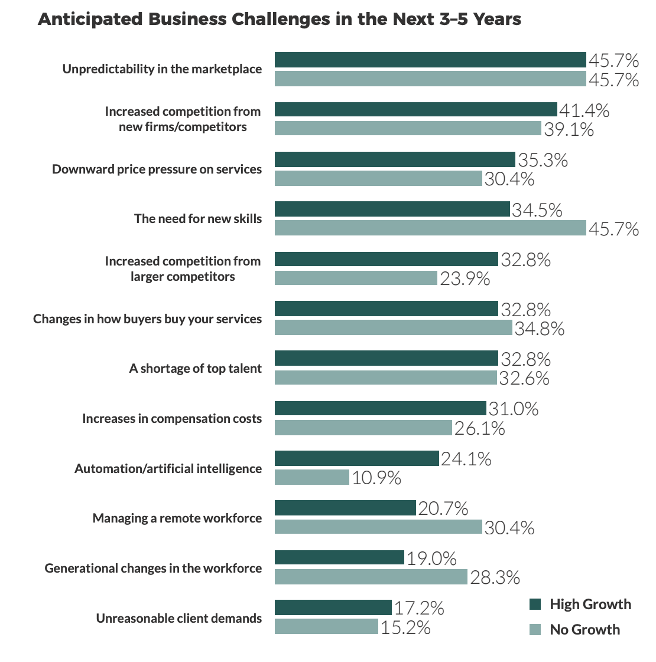When instability is coming from every direction—the economy, political environment, wars, and the job market—how do consulting firms survive and thrive?
Situations like these are exactly why the Hinge Research Institute conducts its annual High Growth Study of the consulting industry in partnership with Deltek. Consulting firms—like all other professional services firms—are still experiencing significant uncertainty. Over 300 consulting firms participated in this year’s study. Their top concern for 2023? Unpredictability in the marketplace, followed closely by a shortage of top talent. Today’s consulting firms are eager to find new ways to raise their visibility, attract new clients and expand their existing client base, but they often don’t know how. One of the best ways to achieve business growth is to learn from the strategies and tactics of the industry’s most successful firms. We call these organizations “High Growth Firms.”
In this article, we highlight a few of the findings from the 2023 High Growth Study: Consulting Edition by outlining the four key advantages of High Growth consulting firms that helped cement their path to growth and profitability. Focusing on what you can control in an uncertain environment will help consulting firms like yours develop a marketing system that delivers powerful results year after year.
To purchase the full report and unlock additional insights and advice, click here. (Use the discount code, GROW50, and save 50% on a report purchase.)
Defining High Growth Consulting Firms
The Hinge Research Institute defines a consulting firm as a “High Growth” firm when it has a compound annual growth rate of 20% or greater over a three-year period. What is impressive is just how fast these firms are growing. In the figure below, we see that High Growth consulting firms grew four times faster than their Average Growth peers.

Not only are the fastest growing firms far outpacing the No Growth and Average Growth consulting firms, High Growth consulting firms are also twice as profitable.
Key Advantage 1: Technology
This year’s data revealed that High Growth firms adopt and use business development and marketing software at a greater rate than their slower growing peers. While digital transformation has been a buzzword in the consulting industry in recent years, the best performing firms are walking the walk. Many consulting firms are likely helping their clients with their digital transformation strategy and implementation. And many High Growth firms have turned these skills inward and are enjoying the benefits of a successful digital transformation. The figure below shows that High Growth Firms are over 3X more likely to have gone through digital transformation than their No Growth peers. There are still many firms, however, that have yet to complete their digital transformation and enjoy the fruits of a fully deployed system. This is a key advantage now, but eventually the pack will catch up to the leaders.

The study also highlights which business development technologies are used by High Growth firms to improve efficiency and use data to understand the evolving needs of clients and prospects. In this way, consulting firms can deliver a more customized solution with greater efficiency to their clients—a win for both sides: better deliverables using fewer labor resources.
Key Advantage 2: Talent
At Hinge, we have been hearing from our consulting clients that it is taking longer to close new business, and prospective clients are pressing for the same value at reduced costs. At the same time, consulting firms are fishing in the same pond for the top talent to meet these higher client demands. In this year’s study, we found that to catch the best people, you need a great company culture built on transparency, authenticity, and team-focused initiatives. We also found that High Growth firms are doing a better job of building that company culture, as illustrated in the figure below. Having a desirable company culture might be the final deciding factor when top candidates are deciding between multiple offers.

In the study, we dive deeper into which activities and benefits are most critical to building an appealing company culture. We also explore what specific skills employees at top consulting firms need to meet today’s client needs. We also explore what skills High Growth firms are most likely to outsource, and why.
Key Advantage 3: Marketing
This year’s study dives deeper than ever into High Growth firms’ top marketing priorities, top marketing techniques, use of social media, and how they have expanded the role of the marketing team into non-traditional areas.
There is one question that is on most consulting firms’ minds: “How much should I allocate to my marketing budget?” The figures below show that High Growth firms are spending more on marketing and are seeing a substantially greater number of digital leads.

A crucial way High Growth firms generate those high-quality digital leads is by producing a steady stream of high-quality educational content. In fact, this was the number one priority for all consulting firms in the study. But it’s not enough to simply produce content. You need to produce and promote it correctly. Check out this recent post by Lee Frederiksen to learn why and how a content-based marketing program works.
Key Advantage 4: Strategy
One last advantage enjoyed by High Growth firms is in the realm of strategy. One key differentiator of High Growth consulting firms is that they look forward to the future instead of turning to the past for guidance. With the level of uncertainty in the current market, no one has a crystal ball to make sense of it all. But some key challenges are beginning to emerge, as you can see in the figure below. High Growth firms’ top three concerns are marketplace volatility, increased competition and downward price pressure on services. While there is a great deal of agreement in this list between High Growth and No Growth firms, note the areas where No Growth firms differ most: the need for new skills, managing a remote workforce and generational changes. These are issues that many High Growth firms have already dealt with. The biggest area of difference for High Growth firms—automation/artificial intelligence—is an indication of how these firms are looking further ahead than their slower-growing peers. High Growth firms usually see the tide coming in before the others. Firms can look at this list to gauge where their business challenges stack up. Is your firm worried about the wrong thing and putting too much effort into something that won’t solve future problems?

The full report also examines the role of M&A in the consulting industry, what topics and trends consulting firms want to learn more about in 2023, the way High Growth firms versus No Growth firms are approaching ESG (and why), and how conducting research can inform your firm’s key strategic decisions.
Putting the Data to Work
As we’ve learned over the eight consecutive years we have conducted this study, the marketplace is ever-evolving. If you are feeling the challenges of an uncertain marketplace, you are not alone. Uncertainty is the number one business challenge facing professional services firms today—and consulting firms are no different. What separates High Growth consulting firms from their No Growth peers is the sophisticated marketing system they’ve built to drive growth and profitability, year after year. You can use the data in our report to help your firm navigate the uncertain times ahead and start to build that successful marketing system. And if you need some support, be sure to reach out to us here at Hinge.

